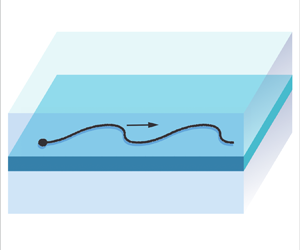No CrossRef data available.
Published online by Cambridge University Press: 29 January 2021

Biological swimmers frequently navigate in geometrically restricted media. We study the prescribed-stroke problem of swimmers confined to a planar viscous membrane embedded in a bulk fluid of different viscosity. In their motion, microscopic swimmers disturb the fluid in both the membrane and the bulk. The flows that emerge have a combination of two-dimensional (2-D) and three-dimensional (3-D) hydrodynamic features, and such flows are referred to as quasi-two-dimensional. The cross-over from 2-D to 3-D hydrodynamics in a quasi-2-D fluid is controlled by the Saffman length, a length scale given by the ratio of the 2-D membrane viscosity to the 3-D viscosity of the embedding bulk fluid. We have developed a computational and theoretical approach based on the boundary element method and the Lorentz reciprocal theorem to study the swimming of microorganisms for a range of values of the Saffman length. We found that a flagellum propagating transverse sinusoidal waves in a quasi-2-D membrane can develop a swimming speed exceeding that in pure 2-D or 3-D fluids, while the propulsion of a 2-D squirmer is slowed down by the presence of the bulk fluid.